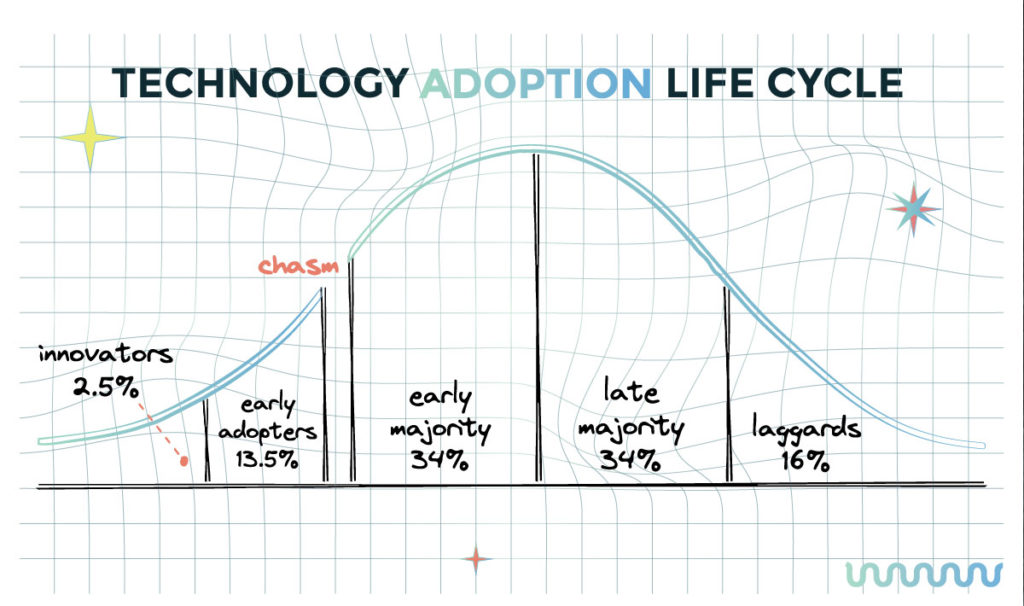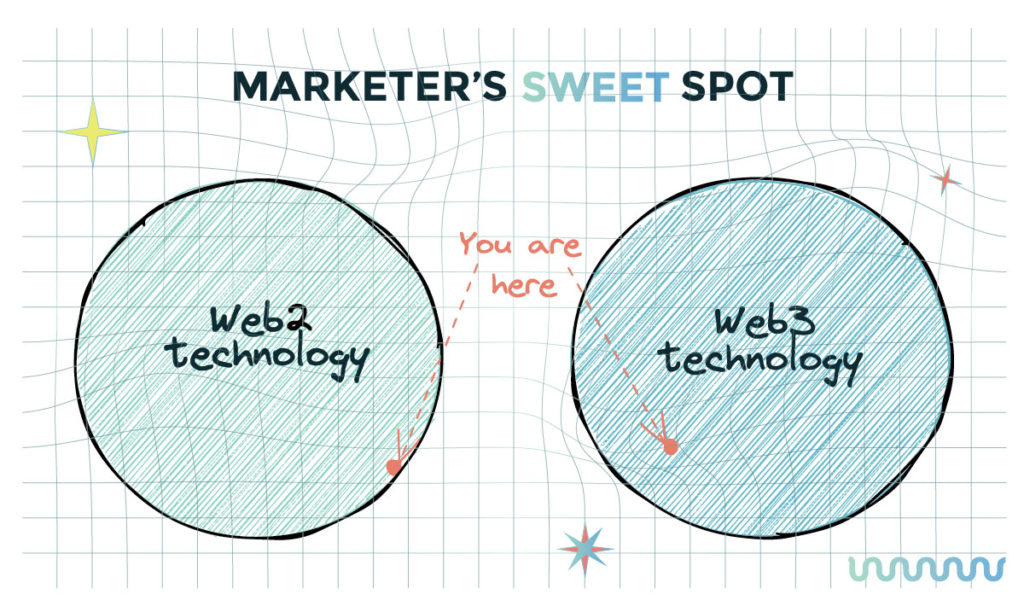
How to Write Stellar Web3 Content, Even if You Suck at Web3
“Hogwash. Logical salto mortale. You can’t do anything properly if you suck at it.”
Your thoughts may sound this way after reading the title, and you are entirely correct. But here’s another perspective on the title.
Take the very term Web3. It has existed for less than a decade, or to be precise, Gavin Wood coined it in 2014. Back then, only a handful of geeks were deeply involved in crypto.
Even now, eight years later, Web3 still has much to prove before becoming mainstream.
All this leads to one obvious conclusion: everyone sucks at Web3. Still. Yes, even Vitalik.

As Charlie Caplin beautifully said: “That’s all any of us are: amateurs. We don’t live long enough to be anything else.”
But here is an even uglier truth. Some people suck less, and some people suck significantly more at Web3.
The first group: crypto visionaries, innovators, and lunatics that somehow compressed 30 years of regular experience into 10 calendar years, engineers with a massive portfolio of Web3 projects, professional cash grabbers chasing tech hypes, and marketers hazardous enough to make a pivot to crypto world in the time of Bitcoin advent.
The second group: You.
The vast ocean of knowledge and you — a quark in the endless blue — swimming to nowhere.
Web3 seems to rejuvenate the most popular Socratess’ wisdom. “I know that I know nothing” is more applicable in Web3 nowadays than anywhere else.
That said, at first glance, delivering relevant and valuable content seems almost impossible unless you are one of the few Web3 pundits in the world.
Of course, this couldn’t be further from the truth.
With the help of robust mental models, a healthy thirst for knowledge, and a pinch of writing tactics, every writer can deliver “good enough” Web3 content.
Step 1: Accept your new role, forget being a marketer (for a while)
People don’t hate marketing. They hate marketing that is obviously marketing. In web3, making your content sound like a pamphlet is an even bigger sin. The reason lies in the picture below.”

First, you have innovators or enthusiasts. They love the tech language. They want the truth without any tricks, and when they have a problem, they want access to the most technically knowledgeable person to answer it.
Secondly, you’ll write for early adopters or visionaries. This group might not love tech language like the first, but they know they need it. For them, technology is vital as it promises to deliver their dream.
The third group is the least tech-demanding. The early majority consists of pragmatists. They need tech explanations, but only as reliability proofs and risk removers.
“It works like this.”
“Ok, great, now show me how the product will improve my life. Let’s talk about the benefits.”
The fact that this group is twice as big as the first two combined may trick you — they will not be your primary target in most cases.
Regarding that Web3 has not crossed the chasm yet, the penetration into this group is shallow.
The Web3 crowd doesn’t have patience for any kind of beating around the bush. If we’re talking about product releases, for this audience, it’s always straight facts and clear benefits that win over pompous claims and grandiose promises. And for any other kind of content, text or visual, it just has to be genuine. These people can stiff out fake any day of the week and they _will_ dismiss it – imho very rightfully so. In terms of text, you really want to keep it simple, informative and educative, if not stupidly silly when shitposting, while for visuals lo-fi memes and retro-synth animations rule, while highbrow productions just miss the target.
Nikola Janković, Content and Community @Decenter.
To conclude, you’ll write mostly for geeks and exaggeratedly motivated business people. And after having these two settled, you’ll need to touch the nerves of the pragmatists. Tricky? You bet it is.
A panacea for this problem doesn’t exist, but transparency in writing might be of colossal help. Instead of a magical wand, try chalk and board. Instead of being a marketer, try to be a communicator.
In this role, you serve as a bridge between product and consumer, and your task is to transfer the knowledge undamaged. No hidden catches, no beautifying things, no shilling projects, just pure truth. All benefits and all flaws must be served on one plate.
But that does not mean you should turn off your inner marketer.
You are not a messenger only.
You still patch communication gaps.
You still play a massive role in embodiment messages.
You still refine engineers’ knowledge and make it chewable.
Reading one manual is easy, but reading a dozen would drive everyone crazy. So that’s why marketers are indispensable — we arrange and present truths in the most digestible way possible.
That said, storytelling is not forbidden in Web3. Neither is PAS. Nor any other technique that makes complex ideas less cumbersome.
For truth’s sake, the new technology is unlikely to penetrate deeply into the early majority without a compelling story. Blockchain is no exception. Actually, that’s where you can truly shine.
Step 2: Embrace the Paradigm Shift
While this isn’t entirely precise, let’s say that there are four pillars on top of which Web3 philosophy stands.
a. Community
Imagine it’s 1610. and you’re witnessing one of the most pivotal moments in the history of humankind. The Earth – the center of the known universe – isn’t the center anymore. Now it’s the Sun. Jaw drop. An almost ungraspable change.
One of the “marketing laws” says that a user is a gravitational point of any market, brand, product, or service. Every action you consider takes a user as a crucial element of your equation.
Web3 comes with the Copernican-like Revolution. Users still play significant roles but only as smaller pieces of what is paramount. And that’s community.
Here’s how Rachel Lee, CMO of Standout Authority, defines a web3 community.
“When it comes to Web3, the community is really at the heart of the movement. With Web3, it’s less about monopolies and users, and more about people coming together as a community to make decisions shift instead of a few people making decisions for the masses.”
So, dear writer, before your fingers start dancing over the keyboard, imagine a lively village where locals work together to obtain benefits for all. Yes, something like The Smurfs.
b. Decentralization
If a community is a point around which everything revolves in Web3, then decentralization is the backbone of that system.
As known, Web2 platforms rely on centralization. At early stages, such systems allow faster user aggregation and lower or no costs for participants.
On the other hand, Web3 platforms have the diametrically opposite approach. They use consensus mechanisms such as blockchains to keep the system functioning, plus they leverage cryptocurrencies and tokens to incentivize their participants.
The proper function of decentralization is to allow community participants to work together toward common goals.
I know it sounds too abstract, but stick to that idea until you have that Eureka moment. Then you’ll realize why decentralization truly matters .
c. Privacy
Harvesting users’ data fuels web2 platforms. The flip side of being “user-centric” is nudging and incentivizing users to provide as much private data as possible for a “better-targeted ad experience.”
Web3, a.k.a. “read-write-OWN” internet incarnation, brings privacy data back to its users. But there’s a downside. Instead of dealing with users you know absolutely everything about, in Web3, you encounter mostly pixelated avatars and bizarre pseudonyms talking gibberish-lookalike language.
Data privacy is no joke. It creates a safer internet experience but makes your work harder as well. It requires adaptations both strategically and tactically. That means your writing will be affected too.
d. Collaboration
In Web2, a product is, by definition, an enemy of similar products. The word “enemy” might seem over the top, but at the end of the day, all those products compete for the same customers’ money. If one wins, the others lose. And if your losing steak takes longer, you die.
Web3 operates differently. It would be wrong to say that competition doesn’t exist, but quick wins and losses are less significant than the big picture. The big picture – the community itself.
So to say, collaboration is the mechanism of Web3 growth. For that reason, products, instead of being “unique” and siloed, are designed more like complements of other products. Like Lego pieces which are supposed to create synergy.
Such a mindset directly affects the way you write in Web3. Whether it’s meticulously written brand positioning content or social media brain dump, it all comes down to one simple rule — you’ll hardly succeed alone. Always write with that in mind.
After absorbing these high-level principles, it’s time to move on to the next step. The hardest one, actually.
Step 3: Push yourself out of comfort zone
In Web2, engineers build products, and marketers humanize them. The overlap of the two on Venn’s diagram is minimal, yet the process seems frictionless. As a Web2 writer, you can talk or write for hours about your product without needing to go knee-deep into tech details.
Moreover, the more you talk about benefits (or even better, about emotions as the consequences of those benefits) and less about the product, the better.
In Web3, it’s different. Blockchain is still a novel and immature technology, and people crave to know what’s under the hood.

Of course, you don’t need to learn to code a smart contract in Solidity or to build a dApp, but you’ll have to fiercely get to grips with tech. That requires reading, watching, and understanding a lot of tech-packed materials.
It’s obligatory because if you write superficially about blockchain and similar topics, you will either be wrong and miss the point or be banal and lose the readers. Or, most probable, you’ll be both.
One hack to accelerate your learning curve is to stick to Web3 engineers. Be inquisitive. Ask them everything. Let them back your content with ideas, facts, and insights. Then, even when you mature as a writer, don’t lose them from sight.
A wise king knows what he knows and what he doesn’t. You’re young. A wise young king listens to his counselors and heeds their advice until he comes of age. And the wisest kings continue to listen to them long afterward.
Tywin Lannister
Everything seems less scary when you imagine yourself as king for a second. Let’s move on.
Yes, reading is worthwhile, and asking for help is even more. But there is one thing that can help you make the quantum leap.
Start using protocols and dApps. Get into the crypto game and start learning from the inside. Given that Web3 velocity is supersonic, catching up with news and trends will be even more challenging if you don’t include an emotional component. Invest your time, and it will pay off.
Step 4: Refocusing the writing structure
The typical writing process includes research, text outline, first draft, text editing, SEO, and final polishing. Of course, it is a sequence of events that remains intact in Web3. What is different is that some segments in this process will be more time-consuming than their Web2 counterparts.
I can’t emphasize this enough: However much time you spend on research, double it when it comes to Web3 writing. Or even better, triple it. Research is the most critical and demanding part of writing high-quality Web content.

Starting from the assumption that you suck at Web3, you’ll need to invest a lot more time in finding valuable materials, understanding them and verifying them. The fact that a lot of Web3 content is poorly written produces additional friction.
On top of that, much precious information is hidden in the depths of the internet (discord servers, subreddits, substack newsletters, telegram channels, premium medium articles, and last-year Twitter threads). So brace yourself. It will take time and effort to become nimble in research.
Critical thinking will be your best friend along this journey. Your analysis should be unbiased and based on evidence. Every external info needs to be double-checked. Like you’re an investigative journalist.
But it takes a long time? Yes, but it is more acceptable pain than being black-labeled in case of promoting misleading facts. This is an additional reason why you need engineers by your side. They provide social proof.
If you have done research correctly, outlining and writing can make you feel like going down the slide. Web3 content isn’t that saturated, so even a modest creative person will have plenty of options to find a new angle.
Have fun while writing, and entertain the reader. Even the most rigid and fact-centric engineers sometimes need to relax. But, once again, do not forget the most important rule — avoid sounding like you are selling something. It’ll backfire.
Editing is a slippery ground too. First, it’s a part where you make it or break it. Suppose you succeed in conveying substance while making it memorable. Congratulations. In that case, your content becomes a strong candidate for a viral blueprint of taming the blockchain complexity and making it human.
But, there is one more BUT.
Remember that what you’re writing for enthusiasts and visionaries will sound incomprehensible to pragmatists. And what’s entertaining for the early majority is banal or “already seen” for innovators and early adopters. It’s a rare event to please them all, and every cautious writer should avoid that challenge.
Therefore, every piece of content must have a predefined reader persona. Binance Academy blog is a solid example of classifying articles into three categories (beginners, intermediate and advanced) following the target groups they address.
Learn through consistency, good examples, and experimenting
One is for sure, you won’t win the Pulitzer prize with your first Web3 article. Quite possibly, it will be mediocre content. But mediocre content is better than no content, right?
Furthermore, no one says that ice-breaking must be spectacular. You can start with a barely noticeable crack and then patiently deepen it with every new piece. Along the way, don’t be shy to experimentand try different approaches, styles, and writing methods. No one knows the silver bullet for writing Web3 content, so feel free to explore the unknown.
And then, one day, the ice will crush loudly. Your content is not mediocre anymore. You still suck at Web3, but you know areas where you feel confident and where you don’t. And you are massively exploiting that fact while gradually expanding the radius of expertise.
Just one more thing before the new beginning. When you are deep in the woods, it’s easier to start moving if you know where the North is.
The following is an ever-expanding list of OK-ish, solid, and excellent content (in no particular order) covering various Web3 niches. Be my guest.
Chainlink blog (also their whitepaper is one of the most detailed ever written in crypto)


